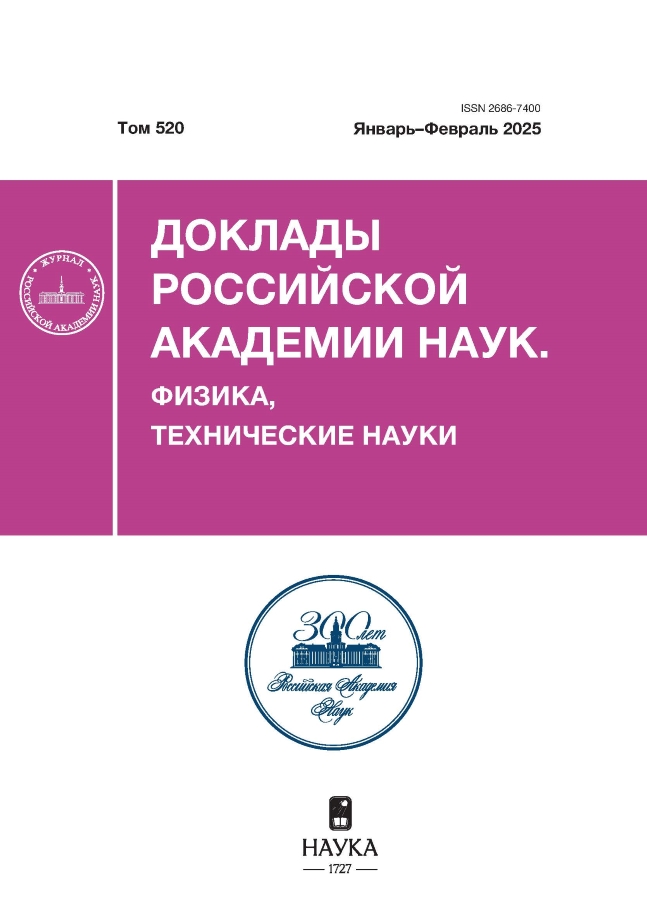Optical sensor based on nano-carbon
- Autores: Bocharov G.S.1, Dedov A.V.1, Eletskii A.V.1, Zverev M.A.1, Sarychev A.K.2, Fedorovich S.D.1
-
Afiliações:
- National Research University “Moscow Power Engineering Institute”
- Institute of Theoretical and Applied Electrodynamics of the Russian Academy of Sciences
- Edição: Volume 520, Nº 1 (2025)
- Páginas: 10-14
- Seção: ФИЗИКА
- URL: https://cardiosomatics.ru/2686-7400/article/view/683270
- DOI: https://doi.org/10.31857/S2686740025010027
- EDN: https://elibrary.ru/GUIQNX
- ID: 683270
Citar
Texto integral
Resumo
The possibility of creating an optical sensor based on carbon nanoparticles used to amplify the Raman signal is discussed. Carbon nanotubes or graphene flakes can be used as reinforcement. This possibility is confirmed by the results of an experiment demonstrating the signal enhancement effect (SERS) when using carbon nanotubes. The possibility of using graphene flakes for this purpose is confirmed by experimental results indicating the presence of plasmonic oscillations in these objects, necessary for the implementation of the SERS effect.
Palavras-chave
Texto integral
Sobre autores
G. Bocharov
National Research University “Moscow Power Engineering Institute”
Email: Eletskii@mail.ru
Rússia, Moscow
A. Dedov
National Research University “Moscow Power Engineering Institute”
Email: Eletskii@mail.ru
Corresponding Member of the RAS
Rússia, MoscowA. Eletskii
National Research University “Moscow Power Engineering Institute”
Autor responsável pela correspondência
Email: Eletskii@mail.ru
Rússia, Moscow
M. Zverev
National Research University “Moscow Power Engineering Institute”
Email: Eletskii@mail.ru
Rússia, Moscow
A. Sarychev
Institute of Theoretical and Applied Electrodynamics of the Russian Academy of Sciences
Email: Eletskii@mail.ru
Rússia, Moscow
S. Fedorovich
National Research University “Moscow Power Engineering Institute”
Email: Eletskii@mail.ru
Rússia, Moscow
Bibliografia
- Fleischmann M., Hendra P.J., McQuillan A.J. Raman Spectra of Pyridine Adsorbed at a Silver Electrode // Chemical Physics Letters. 1974. V. 26. №. 2. P. 163–166. https://doi.org/10.1016/0009-2614(74)85388-1
- Moskovits M. Surface-enhanced spectroscopy // Rev. Mod. Phys. 1985. V. 57. P. 783. https://doi.org/10.1103/RevModPhys.57.783
- Nabiev I.R., Efremov R.G., Chumanov G.D. Surface-enhanced Raman scattering and its application to the study of biological molecules // Sov. Phys. Usp. 1988. V. 31. P. 241–262. https://doi.org/10.1070/PU1988v031n03ABEH005720
- Pilot R., Signorini R., Durante C., Orian L., Bhamidipati M., Fabris L.A. Review on Surface-Enhanced Raman Scattering // Biosensors. 2019. V. 9. № 2. P. 57. https://doi.org/10.3390/bios9020057
- Bantz K.C., Meyer A.F., Wittenberg N.J., Im H., Kurtuluş Ö., Lee S.H., Lindquist N.C., Oh S.-H., Haynes C.L. Recent Progress in SERS Biosensing // Phys. Chem. Chem. Phys. 2011. V. 13. № . 24. P. 11551. https://doi.org/10.1039/c0cp01841d
- Nie S., Emory S.R. Probing Single Molecules and Single Nanoparticles by Surface-Enhanced Raman Scattering // Science. 1997. V. 275. P. 1102. https://doi.org/10.1126/science.275.5303.1102
- Kneipp K., Wang Y., Kneipp H., Perelman L.T., Itzkan I., Dasari R.R., Feld M.S. Single Molecule Detection Using Surface-Enhanced Raman Scattering (SERS) // Phys. Rev. Lett. 1997. V. 78. P. 1667. https://doi.org/10.1103/PhysRevLett.78.1667
- Eletskii A.V., Sarychev A.K., Boginskaya I.A., Bocharov G.S., Gaiduchenko I.A., Egin M.S., Ivanov A.V., Kurochkin I.N., Ryzhikov I.A., Fedorov G.E. Amplification of a Raman Scattering Signal by Carbon Nanotubes // Dokl. Phys. 2018. V. 63. P. 496–498. https://doi.org/10.1134/S1028335818120066
- Kukushkin V.I., Van’kov A.B., Kukushkin I.V. Long-range manifestation of surface-enhanced Raman scattering // Jetp Lett. 2013. V. 98. P. 64–69. https://doi.org/10.1134/S0021364013150113
- Afanas’ev V.P., Bocharov G.S., Gryazev A.S., Eletskii A.V., Kaplya P.S., Ridzel O.Yu. Reduced graphene oxide studied by X-ray photoelectron spectroscopy: evolution of plasmon mode // J. of Physics: Conf. Series. 2018. V. 1121. P. 012001. https://doi.org/10.1088/1742-6596/1121/1/012001
Arquivos suplementares













